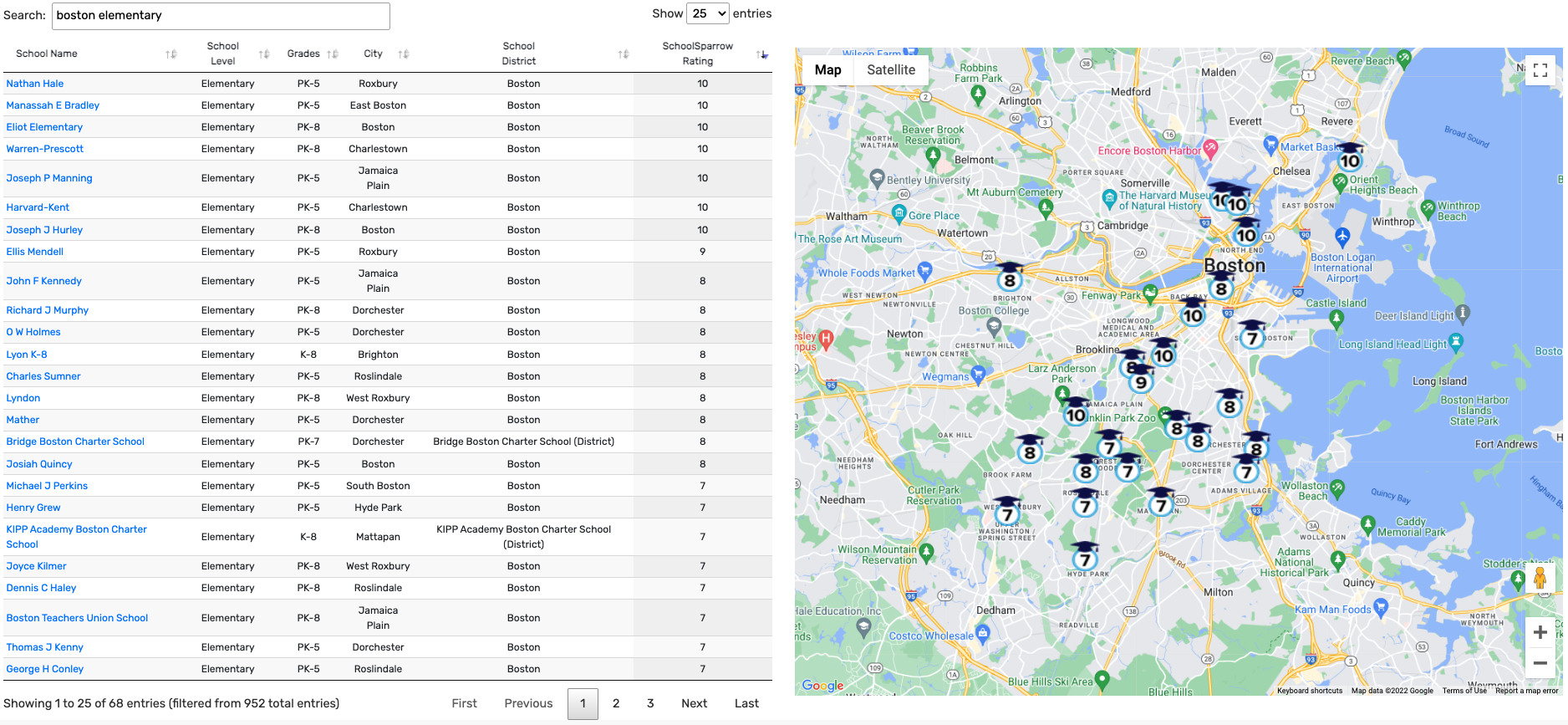Disclaimer: The thoughts, opinions and suggestions of data validity in this article are presented by a contributor. Please make sure to review any local, state, regional and national guidelines before having any major discussions about school rating data with your clients.
Today, when homebuyers ask real estate agents, “Where are the best schools?” many agents refer clients to GreatSchools.org. This is no surprise, considering their ratings are published on Zillow, Redfin and Realtor.com.
The Fair Housing Act (1968) was enacted to address discrimination in housing. It created legal and ethical boundaries for real estate agents in relation to the communities they sell in.
For example, real estate agents are expected to refer clients to outside resources when asked about “good” locations. Data is usually readily available at the local school district’s administrative offices, but it is also good practice to have a few reliable web resources on hand.
As the managing broker of Sparrow Realty in Chicago, I’ve helped dozens of families who value public education above most other factors find the right home. I’ve learned how influential GreatSchools’ ratings are, and that most parents want at least a 7 out of 10 rating, especially if they are relocating to a new city, or they’ll pass over the school and the homes and neighborhood the school serves. The question then becomes, are GreatSchools’ ratings a good indicator of school quality?
This is why I dedicated myself to resolving discriminatory practices in real estate, particularly as they relate to biased school ratings, by founding SchoolSparrow as an alternative rating aggregator.
What is GreatSchools and where do they obtain their data?
GreatSchools is the leading nonprofit site providing information that supports parents researching to find a great education for their child. They support schools striving for excellence, and communities working to diminish inequities in education.
GreatSchools collects and analyzes data from all 51 state departments of education and the federal government to provide analysis, insights and school quality ratings for parents, partners, researchers and policymakers.
How GreatSchools’ ratings system skews the numbers
GreatSchools ratings effectively penalize schools that serve largely low-income students and those serving largely Hispanic and Black students, generally giving them significantly lower ratings than schools serving more affluent communities and more white and Asian students, a Chalkbeat analysis found.
The result is a ubiquitous, privately run school ratings system that is steering people toward whiter, more affluent schools.
GreatSchools’ reliance on test scores tends to give higher scores to schools where parents have the highest incomes and low scores to schools where parents have low incomes. This is because test scores are more correlated with the parent’s education, income and socioeconomic status than how good a school is at teaching.
Furthermore, GreatSchools’ reliance on test score gaps between higher and lower-income students tends to downgrade schools with socioeconomic diversity. While some schools are successfully putting forth efforts to close the achievement gap, and these efforts are important, the achievement gap is a result of a myriad of societal factors. It is not fair to hold public schools fully responsible if an achievement gap exists.
These two measures result in a rating system that gives high ratings to homogenous schools where parents have high incomes and lower ratings to diverse schools where parents have diverse incomes.
Tech note: It is important to research any website or source that is providing statistical data that could potentially influence your viewpoint. The formulations of statistical data can show a variety of results depending on how the formulas are constructed and what data is used in those formulas to create conclusions or support the hypothesis statements about the data.
The GreatSchools impact on neighborhoods and cities
Under the pretense that their public schools are low quality, entire neighborhoods and cities are portrayed as undesirable locations. This has a depressive impact on the economic vitality of those neighborhoods and cities. Take Boston for example. The major real estate search portals currently show two elementary schools that rate 7/10 or better.
With only two “desirable” or “good enough” elementary schools in Boston, parents moving to the area are steered to the suburbs. And this is a problem in virtually every large metro area in the US.
GreatSchools rating data may be influencing your buyer clients away from high-quality public schools where the vibrant diversity of the school and surrounding neighborhood results in a low rating.
Alternative resources provide a more balanced picture
GreatSchools are not the only ratings available. Other sites include Niche and SchoolDigger, and now the site I’ve developed, SchoolSparrow. How are these sites different?
Niche: A market leader in connecting colleges and schools with students and families, offering in-depth profiles on every school and college in America, over 140 million reviews and ratings, and powerful search and data tools. This site uses the most up-to-date data available from dozens of public data sources including the Department of Education, U.S. Census, and FBI.
SchoolDigger: SchoolDigger.com was founded in 2006 to serve one purpose: to empower parents to make informed choices about choosing a school for their child. They use a database that contains detailed profiles for over 136,000 schools in every state in the U.S., including 20 years of enrollment data, several years of test scores, crime data and real estate data.
SchoolSparrow: Uses a rating system, validated by a data scientist out of the University of Chicago, that accounts for parent income when considering standardized test scores, and thus reflects how schools, not socioeconomic status, are influencing student performance.
How different methodologies can lead to different results
SchoolSparrow uses the same number system used by GreatSchools, meaning a 6/10 is average, 7/10 is above average, etc., leading to less confusion and more clarity for those accustomed to GreatSchools ratings.
Consider SchoolSparrow’s ratings for elementary schools in Boston. Today, over two dozen elementary schools in Boston are rated 7/10 or higher.

How better ratings help you (and your clients)
In my 12 years of experience as a real estate agent, I’ve watched many families who care deeply about diversity end up sacrificing it by chasing higher school ratings and affordability. This often results in higher commute times as well.
Remember to offer resources but do not attempt to influence your clients in one direction or the other. Try to remain neutral. Alternative ratings websites and resources will identify schools that your clients might otherwise overlook, often in more affordable neighborhoods closer to the urban core. Parents will appreciate your knowledge about alternative resources when it comes to the very personal decision of school choice.
One thing I personally do when I’m listing a property in the boundaries of an underrated public school is to add the higher rating in the property description and name the source. This makes consumers aware of alternative measures of school quality, and it shows you are doing everything possible to sell your client’s home.
Make sure to check with your local MLS and supervising broker to determine if this is permitted in your listing descriptions.
For agents who are working in areas where schools are underrated, here are some ways you can counter GreatSchool’s low ratings:
- Make consumers aware of alternative ratings. Point to higher ratings on Niche, SchoolDigger and SchoolSparrow in conversations with your clients and on parent message boards.
- Encourage your clients to talk with the local school board and tour multiple schools in person.
- Create quick, interactive hyperlinks to school district contact information and local government resources that are easy to share with clients in an email template or on your personal website to help them with their research.
This point of differentiation can bring more families through a listing and increase the chances of a sale. And importantly, these efforts will help elevate thousands of schools nationwide that are unfairly underrated by today’s dominant school rating system.
Tom Brown has worked as a commercial real estate developer, and in 2009 he started a real estate investment and brokerage business now known as Sparrow Realty. Sparrow has focused on two niches: public transportation and public schools. Brown founded SchoolSparrow in 2019 to help buyers discover more truth about school quality. Follow him on Facebook and LinkedIn.



 Are You Interested in West Eleventh Residences Miami?
Are You Interested in West Eleventh Residences Miami? Are You Interested in ONE Park Tower by Turnberry?
Are You Interested in ONE Park Tower by Turnberry? Are You Interested in Diesel Wynwood Condominium?
Are You Interested in Diesel Wynwood Condominium? Are You Interested in Five Park Miami Beach?
Are You Interested in Five Park Miami Beach? Are You Interested in Cipriani Residences Miami?
Are You Interested in Cipriani Residences Miami? Are You Interested in Bentley Residences Miami?
Are You Interested in Bentley Residences Miami? Are You Interested in Baccarat Residences Brickell?
Are You Interested in Baccarat Residences Brickell? Are You Interested in Aria Reserve Miami?
Are You Interested in Aria Reserve Miami? Are You Interested in 888 Brickell Dolce & Gabbana | Miami?
Are You Interested in 888 Brickell Dolce & Gabbana | Miami? Are You Interested in 600 Miami WorldCenter?
Are You Interested in 600 Miami WorldCenter? Are You Interested in HUB MIAMI RESIDENCES?
Are You Interested in HUB MIAMI RESIDENCES? Are You Interested in WALDORF ASTORIA RESIDENCES?
Are You Interested in WALDORF ASTORIA RESIDENCES?